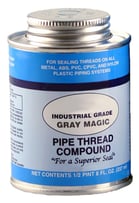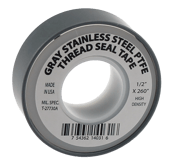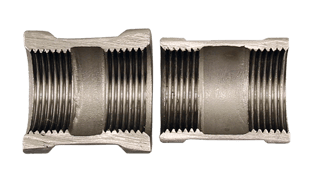Stainless Steel fittings, nipples, clamps, and other products are gaining popularity in more conventional plumbing applications. This is due to the increased cost of other materials such as No-Lead Brass, as well as, Contractors seeing more value in the properties of stainless such as the increase corrosion-resistance.
It is important to know that there are a number of misconceptions in the industry about Stainless Steel Products. These are very important to address because they lead to poor education in the marketplace. In this blog, we will look into 3 of the common misconceptions so that you have a better understanding when these questions come up.
The 3 misconceptions that we are going to dive into, are:
- Real Stainless Steel is Magnetic
- Stainless Steel Fittings and Nipples are sealed the same as other materials
- All Stainless Steel Fittings are the same
Magnetism of Stainless Steel
This is one of the most common misconceptions that we hear in the market. You will hear people say things like:
"the best way to check if something is really Stainless, or a good quality Stainless, is to stick a magnet to it. If the magnet does not stick to it, you have Stainless product. If it does, the quality may not be good, or it could be another material all together."
There is allot of confusion on the topic because Austentic Stainless Steels are indeed non-magnetic in their pre-worked state. However, once the Stainless has been cold worked in the manufacturing processes, it will become magnetic, even though the quality and alloy specification has not changed.
To be clear, the degree of magnetism is not an indicator of the materials corrosion resistance. The "magnet" test will not give you a clear answer to the grade or quality of stainless for plumbing products. It is important to know that lower grade stainless steels such as 200 series will have lower magnetic attraction than a much more corrosion resistant 300 Series stainless steels. For example 301 Stainless steel is much more corrosion resistant, although it does become magnetic when cold worked.
So, the real answer is that a Stainless Fitting for example may have varied degrees of magnetic attraction. The truth is it really doesn't matter. What matters is the alloy composition of Stainless, particularly the percentage of Chromium which forms a oxide layer on the steels surface. This layer is also referred to as the passive layer. In 316 stainless the addition of molybdenum gives 316 better overall corrosion resistant properties than Grade 304, particularly higher resistance to pitting and crevice corrosion in chloride environments.
The real answer is that a Stainless Fitting for example may have varied degrees of magnetic attraction. The truth is it really doesn't matter.
The percentage of nickel is also important in high chromium stainless steel. Nickel increases strength, impact strength and toughness, while also improving resistance to oxidization and corrosion.
The only way to really make sure on the quality is with an alloy analyzer. This will tell us what the exact chemical make up and the quality and corrosion resistance of the alloy.
Stainless Steel Fittings and Nipples are Sealed the Same as other Materials

The biggest push back that I hear about Stainless is that it doesn't seal well, or it is hard to work with. The main reason that people experience this is due to the fact that they don't understand that sealing Stainless has to be done differently than brass, for example.
The reason that it needs to be sealed different is due to the hardness of the material. Using conventional PTFE tape doesn't work well because the Stainless threads will actually cut the tape. This can essentially fuse the fitting and pipe together, which makes it hard to get apart and there will not be a good seal.

Stainless should be sealed using a tape that has nickel in it. The nickel gives the tape increased strength and will not be cut when tightening.
It is also recommended that Stainless pipe dope is used with the tape. This will create a perfect seal, and you will also be able to get the threads apart if needed.
For more information on sealing Stainless, check out this blog.
Once you understand how to seal Stainless Steel Fitting and Nipples properly, working with it is actually pretty easy. With the right instructions and installation products, you can become an expert in no time!
All Stainless Steel Fittings are the Same
Stainless Steel is a widely used term. It is very important to understand that there are many types of stainless. The reason why you need to know about this is because the type of stainless used will come into play when determining the right type for a certain application.
The main types of stainless that you will see in the plumbing industry is 304 and 316 grade. These numbers refer to the chemical make up of each. The main difference between these two is corrosion resistance. 316 Stainless fittings are much more corrosive resistant, and therefore, are suitable for industry, commercial and other applications. 304 is more of a conventional stainless that would be used in more "everyday" plumbing. Compared to other materials like brass or galvanized, 304 is still much more corrosive resistant.

The next aspect to pay attention to is fitting thickness or pattern. There are about 5 different patterns that you may come across. These will deliver different pressure ratings. Obviously, the thicker the pattern, the greater pressure rating it will have.
This is one of the biggest issues I hear from people. There may be 15% price difference between 2 fittings, and usually this is due to either the pattern difference or the stainless type (304 vs. 316).
When comparing Stainless pricing, taking type of material and pattern into account is the only way to get accurate information.
All Stainless fittings are not the same. There are many different configurations and it is important to know about them. Doing a proper comparison hinges on knowing this information.
Conclusion
Stainless Steel Plumbing products are continuing to grow in popularity. Because it is still new in many markets, these misconceptions are still prevalent. It is important to arm people with this correct information so that they are able to make the right product recommendations and ensure success for your customers.
Have further questions about this subject?

Head over to Boshart's Knowledge Base: technical product information, guidelines, and more.





SHARE